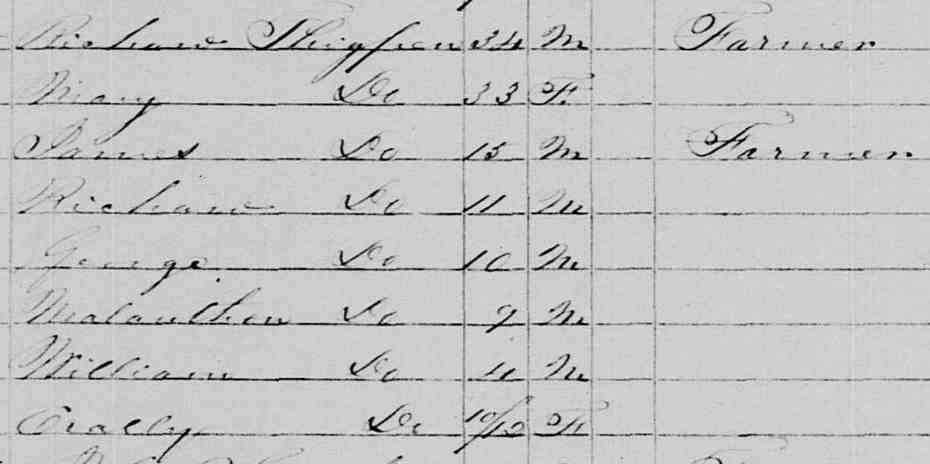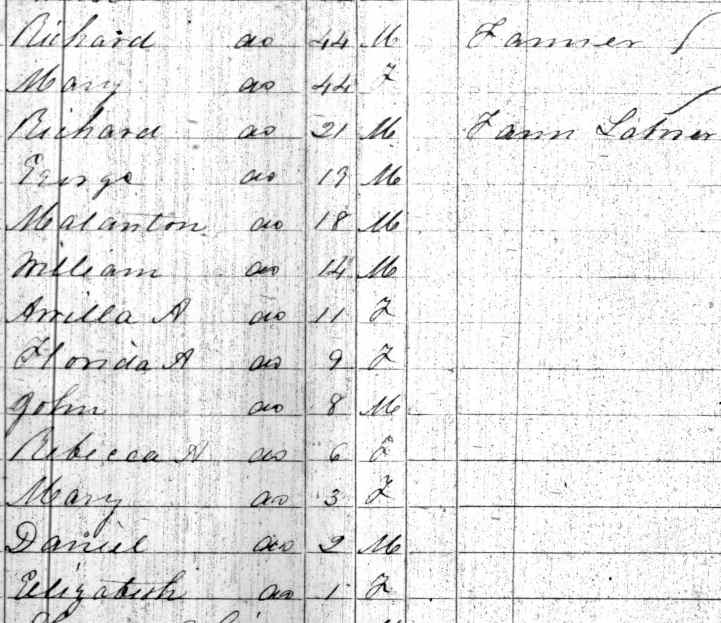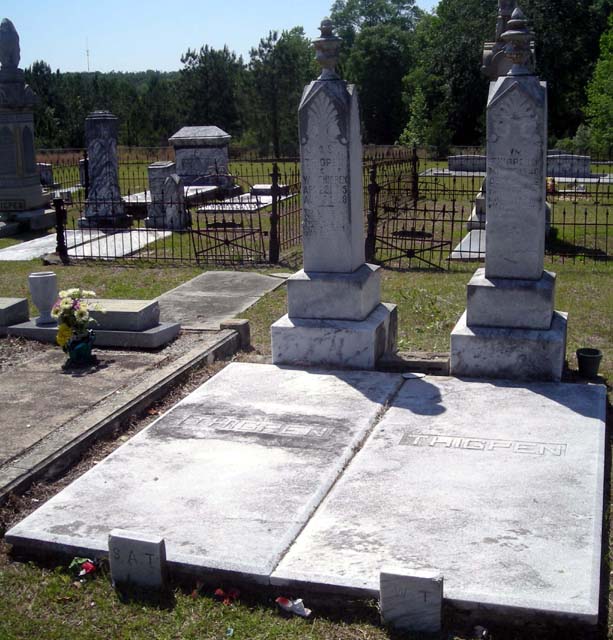- map
- how you can help
- FAQ's
- contact
- copyright
-
ahnentafel and citation # display:| |

| Snapshot: | farmer; Confederate soldier; died of dengue fever |
| Parents: | 72Richard Thigpen 73Mary ___ |
| Born: | 18 March 1846 Laurens County, Georgia |
| Died: | 26 October 1922 about noon Rockledge, Laurens County, Georgia |
| Buried: | Thigpen cemetery, Laurens County, Georgia Coordinates: N32.45203 W82.70423 |
| Alleged photograph: On 10 May 2015, Ancestry.com user Nicole Smith uploaded a photo (titled simply "Android Photo") tagged as showing 36William M. Thigpen and 37Serena Williams. Unfortunately, Nicole doesn't cite a source or even mention the photo's origins in a more casual way. Therefore, one can't be confident in the identification or even that the photo isn't an outright forgery. Nevertheless, if you are aware of the shortcomings but still want to see the photo, click here. |
The 1850 and 1860 censuses show 36William with his family in Laurens County.



Less than a year later, though, the Civil War began, and it would prove ruinous for 36William and his four older brothers (James, Richard, George, and Malenthen), all five of whom served in Company B of the 57

When did The first two dates (i.e., January 1862 and March 1863) seem unlikely for two reasons: (1) I have no evidence to help distinguish whether |
Below I've summarized some of the battles, skirmishes, living conditions, and other interesting events that the 57
Andersonville

The regiment soon was needed in north Georgia to help resist Sherman's advance toward Atlanta. When the troops left Andersonville on 14 May, there was a grand picnic—complete with a band from Macon (which played "The Girl I Left Behind Me" and other tunes, according to the diary of John Ransom, a Union prisoner who witnessed the event), a crowd of women, and dancing—to give the soldiers a send-off.
Allatoona and Dallas
On 20 May 1864 the regiment reached their destination: Allatoona Station, where they joined other troops in Mercer's brigade as part of the Army of Tenneessee. They arrived to find the Army taking strong defensive positions around Allatoona Pass, but many felt demoralized because General Joseph Johnston had recently lost an important opportunity to halt Sherman.
However, Sherman strategically avoided Allatoona Pass, so Johnston repositioned his forces in the area around Dallas, Georgia, resulting in the Battle of Dallas, during which Mercer's brigade helped drive Union forces from the strategic Elsberry Mountain near Dallas.
Gilgal Church
After the Battle of Dallas, on 4 June 1864 Johnston's Army withdrew from the Dallas area, searching for a defensible position closer to Atlanta. They spent that night marching ten miles through the darkness in heavy rain and knee-deep mud.
Starting on 8 June, Mercer's brigade was placed on picket duty; their days mostly consisted of rain, artillery duels, and deaths by sniper fire.
The Battle of Gilgal Church began around noon on 15 June when Mercer's brigade, serving as advance troops for Hardee's corps near Gilgal Church, found itself facing intense Union artillery fire. They remained heavily engaged until 1:30 PM, when they received orders to retreat; several men were killed or wounded as they retreated under fire.
Kennesaw Mountain
On 18 June, Mercer's brigade again had picket duty, protecting Johnston's Army as it aligned into a new defensive perimeter.
The Battle of Kennesaw Mountain broke out on 27 June 1864. Mercer's brigade, positioned on a steep hillside overlooking a meadow near Burnt Hickory Road west of Marietta and south of Kennesaw Mountain,

After the battle, neither Army left the area right away. Most remained uncomfortably crammed in their trenches while sniper fire and artillery duels caused more deaths. Poor hygiene, lice, and diarrhea (caused in part by the inability to preserve food, which mostly consisted of corn bread and bacon or stringy beef) also weakened many. Wounded Union soldiers were left in the battlefield between the two lines to burn in the summer sun and die, while the dead bodies bloated. On 29 June a 7-hour truce was called so that the rotting corpses could be moved into mass graves.
Although the Confederates technically won the Battle of Kennesaw Mountain, Johnston's Army was flanked yet again and so would have to withdraw closer towards Atlanta. Around 11 PM on 2 July 1864, Hardee's corps (including Mercer's brigade and its 57th Georgia Regiment) left their trenches to begin the march towards Atlanta. Demoralized, a significant number of Confederates deserted and went to the Federal lines.
Smyrna Camp Ground and the Chattahoochee River
The night was unusually dark, and the road narrow, so it took Mercer's brigade seven hours to march four miles. After passing through the campus of the Georgia Military Institute (which would be burned to the ground by Sherman's troops, never to be rebuilt), by 6 AM on 3 July they arrived at Smyrna Camp Ground, where they would skirmish with Sherman's troops later in the day.
Correctly fearing that Sherman would flank his lines, on 5 July Johnston withdrew his Army to inconquerable fortifications along the north banks of the Chattahoochee River,
Peachtree Creek
On the morning of 18 July 1864, Mercer's brigade learned that Confederate President Jefferson Davis, tired of Johnston's retreats, had removed him from command and replaced him with John Bell Hood. Johnston had been widely admired by his Army, but Hood had a much-deserved reputation for overzealous recklessness, so this replacement greatly affected the Army's morale.
Hood's eagerness to engage Sherman severely undermined the Army's efforts. The Confederate preparations and command structure were horribly inadequate (and in some cases virtually absent) for the Battle of Peachtree Creek on 20 July 1864.
Hood's Army retreated into Atlanta throughout the day on 21 July 1864.
Walker's Division (which included Mercer's Brigade, and thus also the 57th Georgia and presumably

As they passed through Five Points, "they found much drunken looting taking place in the glare of burning buildings. With Union shells whistling overhead and vandals shattering store windows, a feeling of lawlessness and violence pervaded the city."

Unfortunately, Hood's plan for a well-coordinated, surprise attack at dawn failed: A long night march by exhausted troops proved unrealistic. Hundreds fell along the road during the march, unable to continue. By dawn (when the assault was supposed to begin) many troops still weren't in position. Even worse, because the Union forces knew an attack was imminent and had time to respond, when the assault finally began around noon, the original orders no longer matched the reality of the situation on the battlefield.
As part of Mercer's brigade, during the early minutes of the battle
Later in the day Mercer's brigade joined an effort to capture Bald Hill, a little ways to the northwest. Although they made some initial progress, eventually the Confederate advance became bogged down, and the Federals still held Bald Hill as night fell. A commander in Mercer's brigade wrote in his journal, "We remained all night in the work greatly exposed to fire of sharp shooters. The position being raked by the enemy's artillery." The next day neither side seemed eager to renew the fighting, and at noon a truce was called to remove the dead and wounded, effectively ending the battle.
Although fighting occurred elsewhere,
Jonesboro
As in previous battles, the Confederates' efforts during the Battle of Jonesborough (Jonesboro) were hampered by poor planning and coordination. The Confederates suffered an unusually lop-sided defeat, effectively dooming Atlanta and ensuring Abraham Lincoln would win re-election.
On the second day of the battle (1 August 1864), part of the 57th Georgia (I don't know whether
That evening Hood ordered the evacuation of Atlanta, with all remaining supplies to be destroyed before Sherman could occupy the city the next day. All the Confederates in the area were to re-assemble at Lovejoy's Station. The Confederates near Jonesboro began to withdraw around 10 PM and marched all night to Lovejoy's Station. Colonel Olmstead of Mercer's brigade described the night march: "[...] marching all night reached Lovejoy's Station on the Macon and Western Railroad about daylight. The memory of that night's march is like a horrible dream. I was so tired physically as scarcely to be able to sit on my horse, and the mental depression, deep enough because of our own failure, was the more profound as the red glare in the Northern sky and the sullen rumble of distant explosions told that Hood was burning his stores and abandoning Atlanta to Sherman. The long campaign had ended in defeat and disaster."
This night was famously depicted in Gone with the Wind:
Home
Documents

After the war the U.S. Congress passed several Reconstruction Acts. Among other directives, these Acts required that any Southerner who wanted register to vote in upcoming elections had to swear an oath of loyalty to the United States; the obvious intent was to disfranchise any lingering Confederate resistance.


He married 37Serena Williams on 22 September 1875.

After his father's death in 1897,

In 1910 they were still in Laurens County. They had had ten children, all still living, and two were still living at home.

By 1920









1: "Mr. William Thigpen Died Yesterday: An Esteemed Pioneer Citizen of this Section," The Soperton News (Soperton, Georgia), 27 October 1922, page 1, column 3
2: Georgia Archives RG 58-1-1, Confederate pension application for William Thigpen, Sr. of Laurens County; image 2 ("Questions for Applicant," dated 26 September 1913). Virtual Vault, <https://vault.georgiaarchives.org/digital/collection/TestApps/id/451262/rec/15>, accessed 1 February 2020.
3: Laurens County, Georgia death certificate 26592 for William Thigpen. FamilySearch, <https://familysearch.org/pal:/MM9.3.1/TH-567-11221-2432-69?cc=1320969>, accessed 18 December 2014.
4: 1850 U.S. Federal Census (Population Schedule). District 49, Laurens County, Georgia. Page 234A, dwelling 75, family 75, Richard Thigpen household. NARA microfilm publication M432, roll 75. FamilySearch, <https://familysearch.org/pal:/MM9.3.1/TH-267-11929-126937-47?cc=1401638>, accessed 18 December 2014.
5: 1860 U.S. Federal Census (Population Schedule). Laurens County, Georgia. Page 583, dwelling 37, family 36, Richard Thigpen household. NARA microfilm publication M653, roll 129. Internet Archive, <https://archive.org/stream/populationschedu129unit#page/n89/mode/1up>, accessed 18 December 2014.
6: Lillian Henderson, compiler, Roster of the Confederate Soldiers of Georgia, 1861-1865 (Longino & Porter, Inc., Hapeville, Georgia, 1960), pages 941-942
7: Pension application, op. cit.; image 4 ("Questions for Applicants to Answer," dated 10 May 1915)
8: ibid., image 5 ("Questions for Witness as to Service," dated 10 May 1915)
9: Compiled Confederate service record of Private William Thigpen of Company B, 57th Georgia Infantry. NARA microfilm publication M266, roll 540. National Archives Catalog, <https://catalog.archives.gov/id/79089534>, accessed 23 February 2020.
10: "Loss of the 57th Georgia Regiment at the battle near Champion's farm, 20 miles east of Vicksburg, Miss., Saturday, May 16th, 1863, Col. Wm. Barkuloo, commanding," The Macon Telegraph (Macon, Georgia), 27 May 1863, page 2, column 3, about halfway down the page.
11: Scott Walker, Hell's Broke Loose in Georgia: Survival in a Civil War Regiment (The University of Georgia Press, Athens, Georgia, 2007), pages 108-109
12: Tallies of Andersonville prisoner deaths for April and May 1864. NARA microfilm publication M1303, roll 6, target 2, volume 42 ("Consolidated Monthly Report of Federal Prisoners of War Confined at Andersonville, GA, April 1864-May 1865."), pages 134-137. FamilySearch ("Georgia, Andersonville Prison Records, 1862-1865," Claims and Reports, Vol 42 Consolidated monthly reports 1864 Apr-1865 May, images 2-5 of 28), accessed 4 January 2015. The death counts for 22-30 April 1864 were 15+27+15+18+19+15+43+16+14, respectively. The death counts for 1-14 May 1864 were 18+6+27+13+25+17+20+20+18+31+22+17+24+27, respectively. The sum from all these dates is 467.
13: "Andersonville Prison, Ga., August 17, 1864." Library of Congress, <http://www.loc.gov/pictures/item/2012649366/>, accessed 4 January 2015.
14: Walker, Hell's Broke Loose in Georgia, op. cit., pages 111-112
15: ibid., page 122
16: ibid., page 125
17: ibid., pages 125-126
18: ibid., page 126
19: ibid., page 128
20: ibid., pages 128-129
21: ibid., pages 131-134
22: ibid., pages 137-140
23: ibid., page 140
24: ibid., pages 141-142
25: ibid., page 144
26: ibid., page 145
27: ibid., page 146
28: ibid., pages 147-148
29: ibid., page 151
30: ibid., pages 153-154
31: ibid., page 157
32: ibid., pages 158-159
33: George N. Barnard, photographer, "Views from Confederate fort on Peachtree street looking south, towards the city, Atlanta, Georgia." Library of Congress, <http://www.loc.gov/pictures/item/2012646707/>, accessed 11 January 2015.
34: George N. Barnard, photographer, View looking north on Peachtree Street. Wikimedia <https://commons.wikimedia.org/wiki/File:Georgia,_Atlanta_-_NARA_-_533419.jpg>, accessed 11 January 2015. This image is discussed here.
35: Walker, Hell's Broke Loose in Georgia, op. cit., pages 164-165
36: ibid., pages 167-168
37: ibid., page 172
38: ibid., pages 176 and 179
39: ibid., pages 179-180
40: ibid., page 188
41: Georgia's 1867-1868 Voter Registration Oath Books. Volume 93 (Laurens County Book 2), page 20, entry 40, William Thigpen. Ancestry.com, accessed 21 May 2012. Although I copied the image from Ancestry.com, the corresponding microfilm at the Georgia Archives is microfilm 296/36.
42: 1870 U.S. Federal Census (Population Schedule). Militia District 344, Laurens County, Georgia. Page 366B, dwelling 916, family 916, Richard Thigpen household. NARA microfilm publication M593, roll 161. FamilySearch, <https://familysearch.org/pal:/MM9.3.1/TH-266-12445-22250-48?cc=1438024>, accessed 18 December 2014.
43: Laurens County, Georgia. Marriage book for July 1870 to February 1879, page 167, marriage of William Thigpen and Serena A. Williams. FamilySearch, <https://familysearch.org/ark:/61903/1:1:KXV6-X8Y>, accessed 17 December 2014.
44: Heritage Center, Laurens County Library, Dublin, Georgia. Mr. Allen Thomas' collection of original Laurens County, Georgia 19
| 16 | April 10, 1897 bond set at $1,000.00. Signed M. Thigpen, R. Thigpen, Jr., William Thigpen, W. L. Gray, and Ordinary Joe M. Fordham. |
| 33 | William Thigpen $30.10 receipt to the Thigpen estate upon payment on a note and account against the Thigpen estate. Signed William Thigpen. |
| 84 | William Thigpen $80.96 receipt to the Thigpen estate for a part of his distributive share of the estate. Signed William Thigpen. |
| 87 | William Thigpen $210.00 receipt to the Thigpen estate for part of his distributive share of the estate. Signed William Thigpen and R. M. Thigpen. |
| 88 | William Thigpen $500.00 receipt to the Thigpen estate for part of his distributive share of the estate. Signed William Thigpen and R. M. Thigpen. |
| 89 | William Thigpen $60.04 receipt to the Thigpen estate for part of his distributive share of the estate. Signed William Thigpen. |
| 90 | William Thigpen $85.20 receipt to the Thigpen estate for his distributive share in full of the Thigpen estate. Signed William Thigpen. |
45: 1910 U.S. Federal Census (Population Schedule). Oconee, Militia District 1338, Laurens County, Georgia. Enumeration district 110, sheet 2A, dwelling 31, family 31, Wm Thigpen Sr. household. NARA microfilm publication T624, roll 199. Internet Archive, <http://archive.org/stream/13thcensus1910po199unit#page/n336/mode/1up>, accessed 15 October 2021.
46: 1920 U.S. Federal Census (Population Schedule). Rockledge District, Militia District 1720, Laurens County, Georgia. Enumeration district 89, sheet 1B, dwelling 14, family 15, Wm Thigpen household. NARA microfilm publication T625, roll 266. Internet Archive, <https://archive.org/stream/14thcensusofpopu266unit#page/n519/mode/1up>, accessed 15 October 2021.
47: Tombstone of Wm Thigpen Sr, Thigpen Cemetery, Laurens County, Georgia at coordinates N32.45203 W82.70423. Photographs taken by Bryant Knight, 26 April 2012.